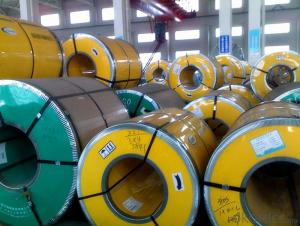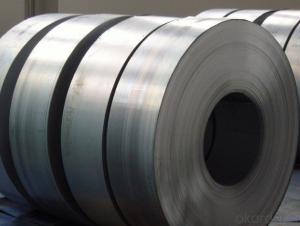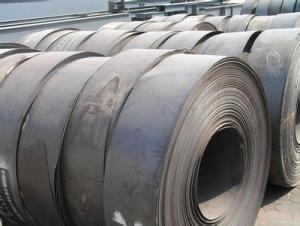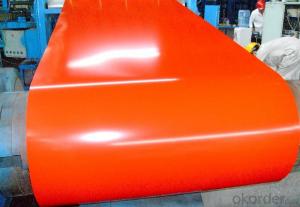Prepainted Zinc/aluzinc Steel Sheet In Coils
- Loading Port:
- Tianjin
- Payment Terms:
- TT OR LC
- Min Order Qty:
- 25 m.t.
- Supply Capability:
- 10000 m.t./month
OKorder Service Pledge
OKorder Financial Service
You Might Also Like
Prepainted Zinc/aluzinc Steel Sheet In Coils
1.Structure of Prepainted Zinc/aluzinc Steel Sheet In Coils
Structure of Prepainted Zinc/aluzinc Steel Sheet In Coils are coated with organic layer, which provides higher anti-corrosion property and a longer lifespan than that of galvanized steel sheets.
2. The base metals for Color Coated Steel Coil consist of cold rolled, HDG electro-galvanized and hot-dip alu-zinc coated steel. The finish coats of Color Coated Steel Coil can be classified into groups as follows: polyester, silicon modified polyesters, polyvinylidene fluoride, high-durability polyester, etc.
3. The production process has evolved from one-coating-and-one-baking to double-coating-and-double-baking, and even three-coating-and-three-baking.
4. The color of the Color Coated Steel Coil has a very wide selection, like orange, cream-colored, dark sky blue, sea blue, bright red, brick red, ivory white, porcelain blue, etc.
5. The Color Coated Steel Coil can also be classified into groups by their surface textures, namely regular prepainted sheets, embossed sheets and printed sheets.
2.Main Features of Prepainted Zinc/aluzinc Steel Sheet In Coils.
1) Rust-proof
2) Water-proof
3)Durable using
3. Prepainted Zinc/aluzinc Steel Sheet In Coils Images
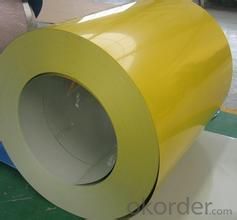

4. Prepainted Zinc/aluzinc Steel Sheet In Coils Specification
goods | Prepainted Zinc/aluzinc Steel Sheet In Coils |
Technical Standard: | JIS 3302 / ASTM A653 / EN10143/EN10327 |
Grade | DX51D / DX52D/ DX53D/ S250,280,320GD |
Width | 500/650/726/820/914/1000/1200/1219/1220/1250mm |
Thickness | 0.17-1.6mm (0.25-0.45mm is the most advantage thickness) |
Type of coating: | galvanized |
Zinc coating | Z60-120g/m2 |
Surface treatment | chromed / skin pass/ oiled /un oiled /slightly oiled/ dry |
Surface structure: | zero spangle / minimized spangle / regular spangle/ big spangle |
| MOQ | 5 Tons |
Package: | Properly packed for ocean freight exportation in 20''containers |
Price terms | FOB,CFR,CIF,CPT.CNF,CIP |
Payment terms | 30%TT in advance+70% TT or irrevocable 70%L/C at sight |
delivery time | 7days after receipt of 30% TT |
5.FAQ of Prepainted Zinc/aluzinc Steel Sheet In Coils
We have organized several common questions for our clients,may help you sincerely:
①How about your company?
A world class manufacturer & supplier of castings forging in carbon steel and alloy steel,is one of the large-scale professional investment casting production bases in China,consisting of both casting foundry forging and machining factory. Annually more than 8000 tons Precision casting and forging parts are exported to markets in Europe,America and Japan. OEM casting and forging service available according to customer’s requirements.
②How to guarantee the quality of the products?
We have established the international advanced quality management system,every link from raw material to final product we have strict quality test;We resolutely put an end to unqualified products flowing into the market. At the same time, we will provide necessary follow-up service assurance.
③What is the usage on the products?
The industrial use
The application field | example illustration |
The electrical appliance industry | Air conditioner,Computer chassis, Plate for refrigerator,Outer shell of washing machine,kitchen fittings, The freezing chamber device |
The building industry | housetop,Lateral wall,doors and windows, gutter,Shutter doors and windows,Wall frame , Ceiling joist,ventiduct |
The agricultural and pastoral | Granary,silo,animal house,trough,flume,Greenhouse trellis,Baking equipment; |
The transport | railroad:The roof of the train,The internal frame of train,The road sign,The inner walls of the train; |
The equipment and structure | radiator,cold roll-formed ,Pedals and rack |
- Q:How are steel strips used in the production of automotive springs?
- Steel strips are commonly used in the production of automotive springs due to their high strength and durability. These strips are typically made of high carbon steel, which provides the necessary rigidity and resilience required for automotive springs. The manufacturing process starts with the steel strips being cut into desired lengths and widths. These strips are then heated and quenched to enhance their strength and hardness. The quenching process involves rapidly cooling the heated strips to create a hardened surface while preserving the ductility of the material. Next, the strips are shaped into the desired spring form using various methods such as hot coiling or cold coiling. Hot coiling involves heating the steel strips and winding them around a mandrel to create the desired shape, while cold coiling involves shaping the strips at room temperature. The chosen method depends on the specific requirements of the spring. Once the springs are formed, they undergo a tempering process to relieve internal stresses and improve their flexibility. This process involves reheating the springs at a lower temperature than the original quenching process, followed by slow cooling. Tempering enhances the spring's ability to withstand repeated loads and prevent failure due to brittleness. After tempering, the springs are usually coated with a protective layer, such as zinc or powder coating, to prevent corrosion and increase their lifespan. This coating also provides an aesthetically pleasing finish. Overall, steel strips play a crucial role in the production of automotive springs by providing the necessary strength, resilience, and flexibility to withstand the demanding conditions associated with vehicle suspension systems.
- Q:What are the different bending methods for steel strips?
- There are several bending methods for steel strips, including press brake bending, roll bending, and rotary draw bending. These methods involve applying force to the steel strip to shape it into the desired curvature or angle.
- Q:What are the different types of coatings used on steel strips?
- There are several different types of coatings that can be used on steel strips to enhance their performance and protect them from corrosion. These coatings can be categorized into three main types: metallic coatings, organic coatings, and conversion coatings. 1. Metallic coatings: Metallic coatings provide a layer of metal on the steel strip's surface, offering excellent corrosion resistance and durability. Some common metallic coatings for steel strips include: - Zinc coatings: Zinc coatings, such as hot-dip galvanizing or zinc electroplating, provide a protective layer of zinc on the steel surface. This coating is widely used to prevent corrosion and extend the lifespan of steel strips. - Aluminum coatings: Aluminum coatings can be applied through various methods, such as hot-dip coating or aluminum vapor deposition. These coatings offer excellent corrosion resistance and can be used in environments where zinc coatings may not be suitable. - Tin coatings: Tin coatings are commonly used to improve the appearance of steel strips and provide a thin layer of protection against corrosion. They are often used in the food industry or for decorative purposes. 2. Organic coatings: Organic coatings are made of polymers or resins and are applied as a paint-like layer on the steel strip's surface. These coatings provide corrosion resistance, as well as aesthetic appeal. Some examples of organic coatings include: - Epoxy coatings: Epoxy coatings offer excellent chemical resistance and adhesion to the steel surface. They are often used in aggressive environments such as chemical plants or offshore structures. - Polyurethane coatings: Polyurethane coatings provide good abrasion resistance and UV stability. They are commonly used in outdoor applications, such as for steel strips used in construction or automotive industries. - Polyester coatings: Polyester coatings are known for their excellent color retention and durability. They are frequently used in architectural applications, such as building facades or metal roofs. 3. Conversion coatings: Conversion coatings are chemical treatments that convert the steel strip's surface into a protective layer. These coatings provide both corrosion resistance and enhanced paint adhesion. Some common conversion coatings include: - Phosphating coatings: Phosphating coatings create a layer of insoluble phosphate crystals on the steel surface, providing corrosion resistance and promoting paint adhesion. They are often used as a pre-treatment before applying organic coatings. - Chromate coatings: Chromate coatings, such as hexavalent chromium or trivalent chromium, are used to protect steel strips from corrosion. They also improve paint adhesion and are commonly used in the automotive industry. Overall, the choice of coating for steel strips depends on the specific application requirements, environmental conditions, and desired performance characteristics. Each type of coating offers unique benefits and should be selected based on the intended use and desired level of corrosion protection.
- Q:Are steel strips suitable for the production of cutting tools?
- Yes, steel strips are suitable for the production of cutting tools. Steel strips are known for their high strength, durability, and excellent hardness properties, making them ideal for creating sharp and long-lasting cutting edges. Additionally, steel strips can be easily shaped, heat-treated, and finished to meet the specific requirements of different cutting applications. With their versatility and reliability, steel strips are a popular choice in the manufacturing of various cutting tools such as knives, saw blades, and shears.
- Q:How do steel strips perform in welding and joining processes?
- Steel strips perform well in welding and joining processes due to their high strength and versatility. They have excellent weldability, allowing for seamless integration with other steel components. Additionally, steel strips offer good formability, making them easy to shape and mold during the welding and joining processes. Overall, steel strips are reliable and efficient materials for achieving strong and durable welds and joints.
- Q:How do steel strips handle vibration or impact?
- Steel strips are very durable and can handle vibration or impact quite well. The inherent strength and resilience of steel make it an excellent material for withstanding these types of forces. Additionally, steel strips can be further reinforced or treated to enhance their ability to absorb vibrations and resist impacts, making them even more reliable in such situations.
- Q:Are steel strips suitable for the production of musical instruments?
- Yes, steel strips can be suitable for the production of musical instruments. They are often used for making components such as strings, reeds, or percussion instruments like cymbals. However, the specific application and desired sound characteristics should be considered as different materials may be more appropriate for certain instruments.
- Q:What are the common applications of hot-rolled steel strips?
- Hot-rolled steel strips have a wide range of applications in various industries. They are commonly used in the automotive industry for manufacturing structural components, such as chassis, frames, and suspension systems. Additionally, hot-rolled steel strips are utilized in the construction sector for fabricating beams, columns, and other structural elements. They are also employed in the manufacturing of pipes, tubing, and storage tanks in the oil and gas industry. Moreover, hot-rolled steel strips are extensively used in the production of appliances, machinery, and agricultural equipment.
- Q:How do steel strips contribute to energy savings in various applications?
- Steel strips contribute to energy savings in various applications through their unique properties and characteristics. Firstly, steel strips are known for their high strength and durability, which allows them to be used in lightweight construction. By using steel strips in place of other heavier materials, such as concrete or wood, less energy is required for transportation and installation. This reduction in weight leads to lower fuel consumption during transportation and reduces the need for heavy machinery during construction, resulting in energy savings. Moreover, steel strips have excellent thermal conductivity, meaning they can efficiently transfer heat. This property is beneficial in applications such as heating, ventilation, and air conditioning (HVAC) systems. By using steel strips in heat exchangers, for example, the transfer of heat is optimized, resulting in more efficient energy use and lower energy consumption. Additionally, steel strips possess high corrosion resistance, making them suitable for outdoor applications. This corrosion resistance reduces the need for frequent maintenance and replacement, resulting in energy savings associated with maintenance activities, such as cleaning, painting, and repairs. Furthermore, steel strips can be easily recycled, making them a sustainable choice. Recycling steel strips requires significantly less energy compared to producing new ones from raw materials. By opting for recycled steel strips, energy consumption in the manufacturing process is reduced, contributing to overall energy savings. Lastly, steel strips have a long lifespan, which reduces the need for replacements and repairs over time. This longevity means that energy is not wasted on frequent replacements or repairs, leading to significant energy savings in the long run. In conclusion, steel strips contribute to energy savings in various applications through their lightweight construction, thermal conductivity, corrosion resistance, recyclability, and long lifespan. By utilizing steel strips, energy consumption is reduced in transportation, installation, heating and cooling systems, maintenance activities, and manufacturing processes, leading to a more sustainable and energy-efficient future.
- Q:Can steel strips be used in the manufacturing of kitchen appliances?
- Yes, steel strips can be used in the manufacturing of kitchen appliances. Steel strips are often used for constructing the bodies and frames of kitchen appliances due to their strength, durability, and resistance to heat and corrosion.
1. Manufacturer Overview |
|
|---|---|
| Location | |
| Year Established | |
| Annual Output Value | |
| Main Markets | |
| Company Certifications | |
2. Manufacturer Certificates |
|
|---|---|
| a) Certification Name | |
| Range | |
| Reference | |
| Validity Period | |
3. Manufacturer Capability |
|
|---|---|
| a)Trade Capacity | |
| Nearest Port | |
| Export Percentage | |
| No.of Employees in Trade Department | |
| Language Spoken: | |
| b)Factory Information | |
| Factory Size: | |
| No. of Production Lines | |
| Contract Manufacturing | |
| Product Price Range | |
Send your message to us
Prepainted Zinc/aluzinc Steel Sheet In Coils
- Loading Port:
- Tianjin
- Payment Terms:
- TT OR LC
- Min Order Qty:
- 25 m.t.
- Supply Capability:
- 10000 m.t./month
OKorder Service Pledge
OKorder Financial Service
Similar products
New products
Hot products
Related keywords
